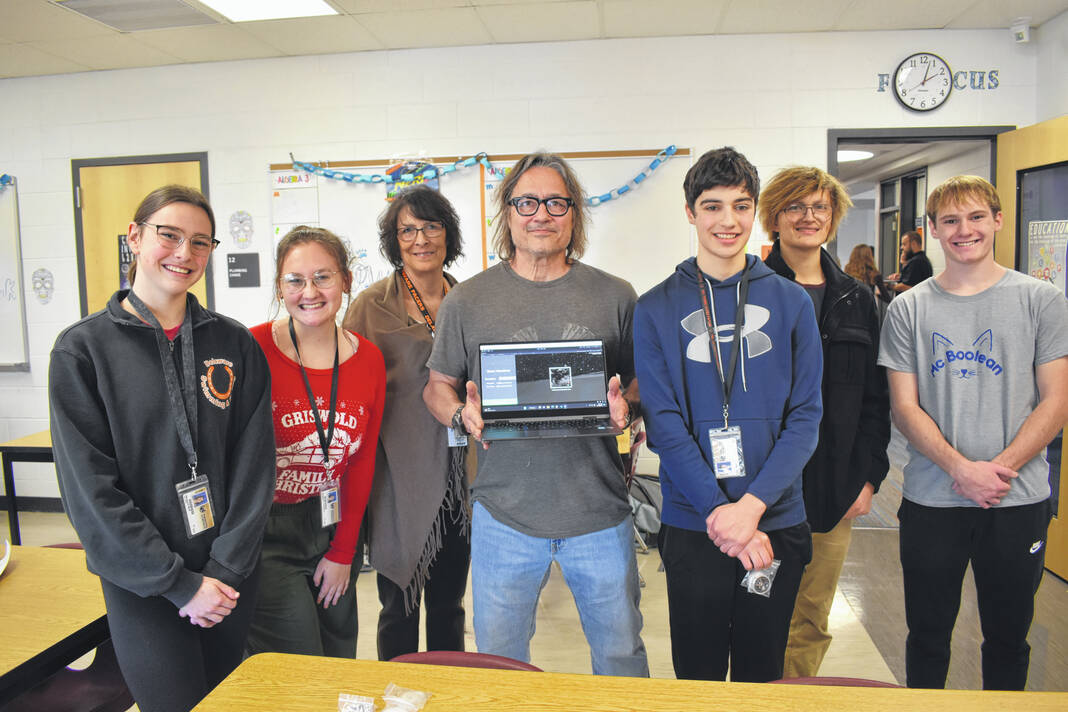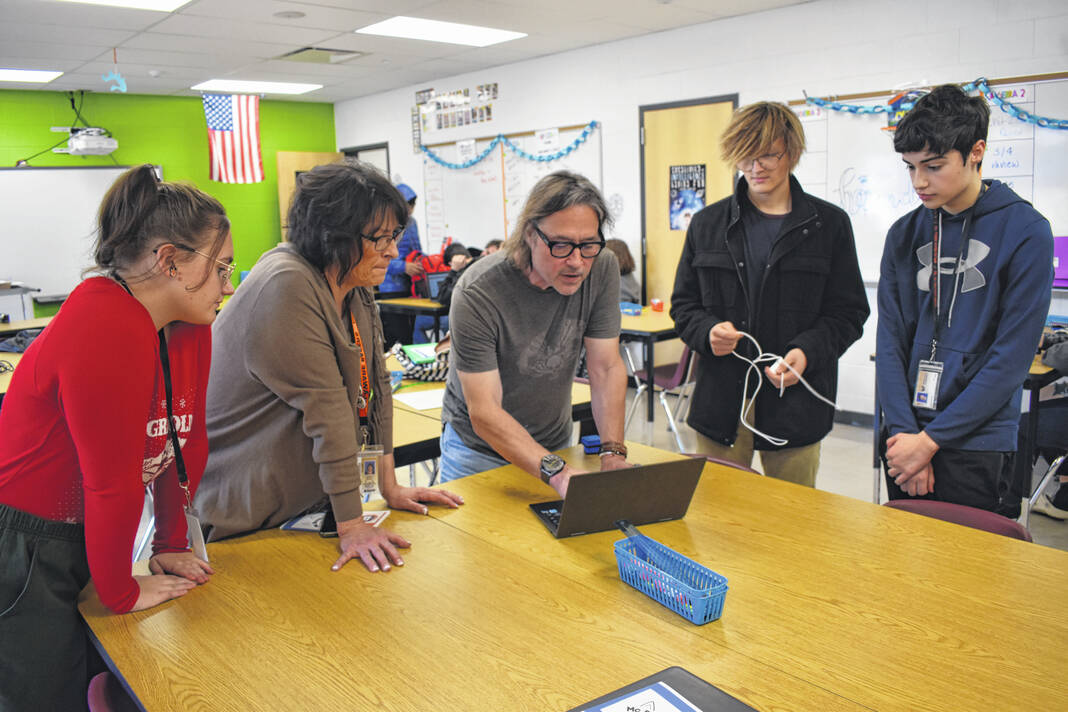

On Wednesday, a team of students at Hayes High School submitted an app they designed to navigate the moon as part of NASA’s App Development Challenge.
Hayes math teacher Joanne Meyer said Tuesday that the team of five students received detailed information about the surface of the moon and had to design an app that would allow a lunar rover to navigate from point A to point B while stopping at 10 waypoints to receive signals from Earth.
As part of the project, teams were allowed to work with a mentor, and Meyer said she reached out to her former schoolmate and friend, Mikel Cvetanovic, who graduated from Hayes in 1981 for help. Cvetanovic, who now resides in Santa Monica, California, is a spacecraft flight software engineer who works on designing software used for satellites.
Cvetanovic mentored the team over video conferencing for 10 weeks and flew out to surprise them Tuesday as they prepared their finalized app for NASA.
“I’ve been mentoring all my life,” Cvetanovic said. “There’s nothing better than taking something you know and sharing it with others so they can know and become better and then maybe they suddenly sprout wings in a new area of interest that they never would have before, especially if that seed isn’t available … like here where we don’t have a computer science program.”
Meyer said that with Cvetanovic’s help, the students programmed the app from the ground up and created dynamic systems to help the rover traverse the moon’s surface.
“What they did was very amazing,” Meyer said. “They built in some artificial intelligence so the rover will go around obstacles. Some of the bells and whistles they put in are amazing.”
Meyer said she hoped the project gave students more than just programming skills.
“I want them to get the experience of working as a team, developing an app in real life,” Meyer said. “I wanted them to get that experience of working together and collaboration.”
Paul Gabel, a senior at Hayes, said he plans to study engineering with a minor in programming when he goes to college next year, and the project was a valuable learning experience.
“We learned a lot by working on the app,” Gabel said. “We had to learn a lot of technology. I don’t think we were planning to win. We did this challenge to learn and get better at programming. It was a lot of fun.”
Jacob Payne, a fellow senior, said he joined the project to learn as much as possible.
“I want to go into aerospace engineering and coding is going to be a really big part of that, so I figured it would be an experience,” Payne said. “Being able to work with a team sounded fun.”
Payne said his favorite part of programming the app was “seeing things come together.”
“That part was really fun,” he said.
His teammate, Adam Fronduti, also a senior, said the project was challenging but fun.
“I don’t think there was anything that worked the first time,” Fronduti said. “Eighty-five percent of our time was spent fixing tiny errors. There were definitely some problems, but we got it finished.
Fronduti said he enjoyed the project and the team experience.
“I think Mrs. Meyer is really cool, and my teammates were really fun to work with,” Fronduti said. “It was fun to work collaborative with other people.”
For Rosemary Cranston, a junior, the project was a dream come true.
“I’ve always had an interest in NASA and space,” Cranston said. “It’s really exciting.”
Cranston said she looked at different angles and slopes for the rover to travel and enjoyed working with the team and Cvetanovic.
“I really liked the collaboration aspect,” Cranston said. “Meeting Mikel and knowing we were working with someone as high status as him … it was just really fun to work with someone like that.”
Senior Meg Wolf said she began coding last year and now plans to study it in college. She said Tuesday that she felt the project would be a good way to learn and practice more coding.
“I knew the opportunity wasn’t something I wanted to miss out on,” Wolf said. “I did everything and anything people needed. We all knew each other, but we would never have had an excuse to do something like this together. It was really fun to get the five of us together and learning to work as a team.”
Wolf said just being one of the 95 teams selected for the project is a great accomplishment.
“Even getting a shot at it is an honor in and of itself,” Wolf said.
Cvetanovic said he’s proud of the student’s work, and he treated them like a real team.
“I told them on day one, ‘Our goal here is to fail brilliantly,’ which means to do so brilliantly that we won’t fail, but if we do, it will be brilliant.” Cvetanovic said. “I didn’t want them to get hung up on ‘we have to be number one.’ I told them we are going to use the same software and tools I use at work. (I told them) ‘I’m not going to treat you like kids, I’m going to treat you as my colleagues that I work with. In terms of schedule, work ethic, collaboration, working as a team … I’m forgetting you are high school kids. If you’re willing to put in the effort and work as you would in the real world … then I’ll be your mentor.’”
Cvetanovic said he hopes the team learned from the experience and hopes they consider the aerospace field in the future.
“I didn’t go easy on them,” Cvetanovic said. “I’m totally overwhelmed with pride. Maybe some students will decide to be computer engineers and rocket scientists after this.”
Cvetanovic added he enjoyed his time at Hayes when he was a student, and he’s proud that he had perfect attendance from fifth grade until he graduated. He said he was happy to give back to his alma mater.
“My days at Hayes were the best years of my life,” Cvetanovic said. “To this day, my roots and everything I am today started here. … It’s a joy for me to be able to give back to the students and see them excited. I’m privileged and grateful that I was called to help students at Hayes and watch them learn.”
The team submitted the app on Wednesday and is expecting to hear results within the next month.



